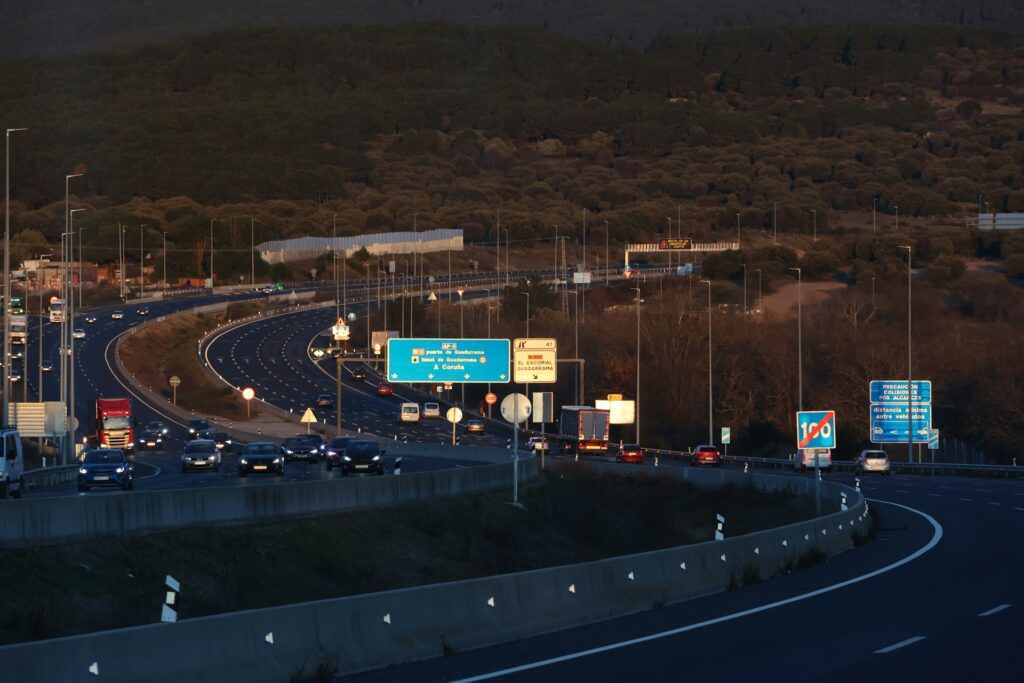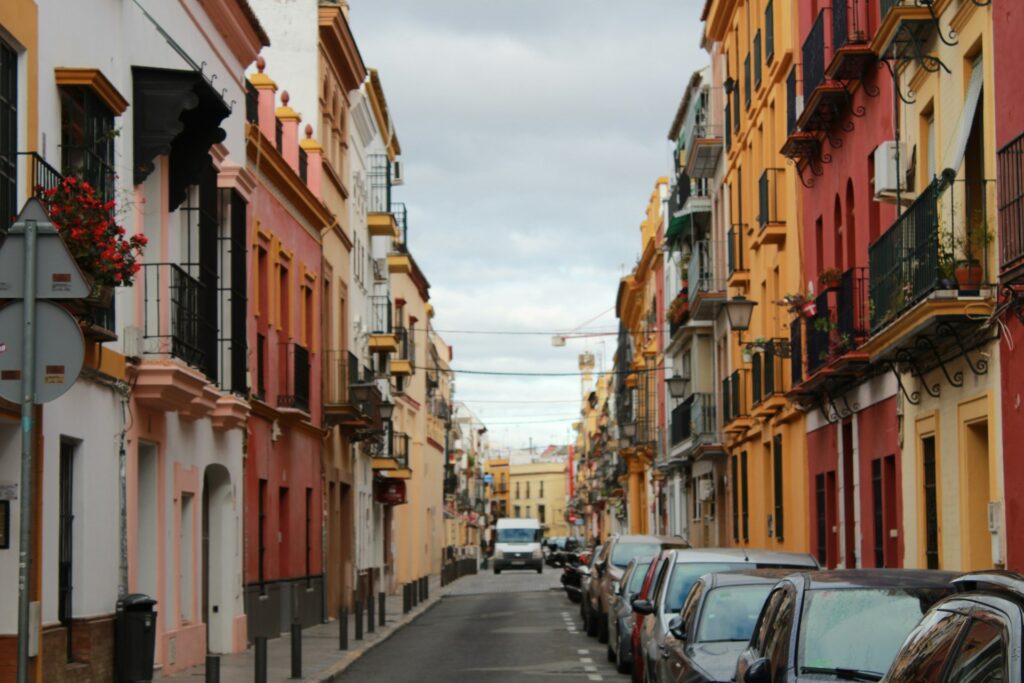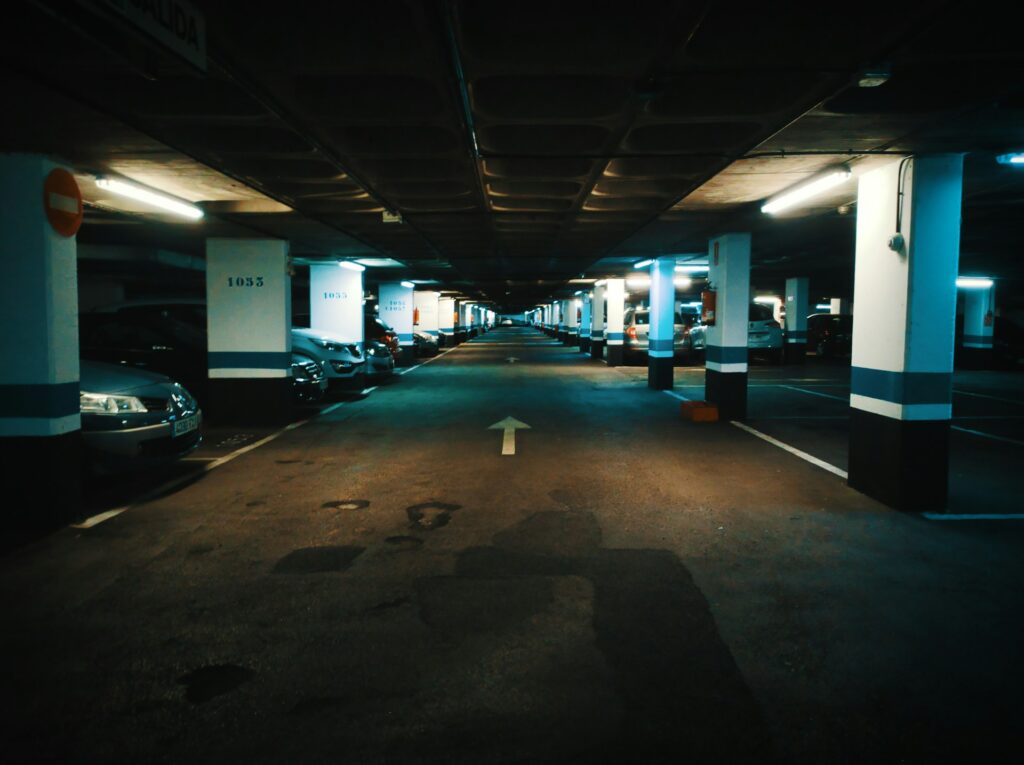
- Speed limits in Spain
- Traffic laws and rules in Spain
- Good to know when driving in Spain
- SIXT car rental in Spain
Spain can be visited all year round, and renting a car in Spain allows you to enjoy the country’s sights at your convenience. Driving in Spain can be a pleasant experience. The roads are great, and there are plenty of scenic routes to explore. From the lush northern coast of Galicia to the sun-soaked fields of Andalusia, from the vineyards of La Rioja to the windmills of Castile, Spain offers breathtaking routes to explore. However, it pays to learn the rules of the road, and this guide provides essential tips for driving on Spanish roads.
Speed limits in Spain
Get familiar with the metric system before renting a car in Spain. Like most European countries, Spain uses the metric system for all road signs. This means that distances and speeds are expressed in kilometers (km) and kilometers per hour (km/h) rather than miles (mi) and miles per hour (mph). Similarly, expect to fill your tank at the gas station by the liter and not by the gallon. Speed limits in Spain are dependent on the type of road and/or location, and the following are the general speed limits:
- Residential roads: 20 km/h (12 mph)
- Built-up areas: 30 km/h – 50 km/h (18 – 30 mph)
- Outside built-up areas: 80 km/h – 90 km/h (50 – 55 mph)
- Motorways: 80km/h – 120 km/h (55 – 75 mph)
You may exceed the speed limit by 20 km/h to overtake a slower vehicle outside the city. Still, this exception doesn’t apply to motorways and dual carriageways, where the speed limit is strictly enforced. Speed limits are strictly enforced in Spain, and speed cameras are a common feature on Spanish roads. There are two types of speed cameras: fixed speed cameras and mobile speed cameras. The fixed speed cameras are situated just above the motorways, while the mobile speed cameras are placed at various locations to monitor speed more effectively. However, a roadside warning sign is always present to alert you that a speed camera is ahead.
Traffic laws and rules in Spain
General & Safety
- Roundabouts: Rotondas or roundabouts are common on Spanish roads, and there are single- and multiple-lane roundabouts. There are two types of roundabouts: controlled (those with traffic lights) and uncontrolled (without traffic lights) roundabouts. Controlled roundabouts are easy to navigate. Navigating uncontrolled roundabouts can be tricky, but generally, vehicles already inside have the right of way.
- Turning right turn on red: Turning right on red is prohibited unless permitted by a sign or traffic light. Most intersections in Spain have a single traffic light, and when it’s red, all vehicles must come to a complete stop. However, in some cases, a separate light allows cars in the right lane to advance, usually showing a green or blinking light.
- Overtaking: In Spain, motorists drive on the right and overtake on the left. Always use your indicators when overtaking, indicating when you’re pulling out and back in. Don’t be alarmed when drivers flash their headlights before overtaking, as most Spanish drivers will give you a warning to let you know they’re about to pass.
- Seatbelts: Whether you’re in the front or back row, seatbelts must be worn at all times, and they must remain fastened during travel.
- Cyclists and bicycle lanes: Cyclists are a common sight on Spain’s roads, and so are bicycle lanes. Bicycle lanes will look different depending on where you are, with some streets having these lanes on the left and others on the right. Cyclists have priority over motorists, and you must always yield to them. Before overtaking a cyclist, ensure the distance between your car and the cyclist is at least 1.5 meters. The maximum speed for overtaking a cyclist must be at least 20 km/h lower than the road’s speed limit.
- Mobile phones: Do not use your phone while driving without a hands-free device. It’s also illegal to drive while using headphones, including over-ear, on-ear, in-ear, wired, wireless, and true wireless (TWS) headphones.
- Uncontrolled intersections: Vehicles approaching from the right have the right of way on uncontrolled intersections.
- Car seats: According to Spanish law, children under 135 cm (4 feet 5 inches) must not sit in the front row and must be in a car seat. Children below 12 years old but taller than 135 cm must be seated in a child restraint system adapted to their size and weight.
- Stopping on highways: If you must stop and exit your vehicle by the roadside for any reason, you must wear a yellow safety vest. All Spanish cars come equipped with one, and wearing it when exiting your vehicle by the roadside is mandatory.
- Pedestrians: Yield to pedestrians at all times.
- Low-emission zones: Some of Spain’s big cities, including Barcelona and Madrid, have low-emission zones that can only be accessed by electric or hybrid vehicles. Electric vehicles have blue “0” stickers, and hybrid cars have blue and green “ECO” stickers on the windshield, granting them access to low-emission zones. Vehicles with yellow “B” or green “C” stickers are not allowed into low-emission zones.
Types of roads in Spain

Spain’s road system comprises different types of roads; some have tolls, but most are free to use. There are four types of roads in Spain, and for the most part, the streets in Spain are of excellent quality. Here are the main road types you should know when driving in Spain.
Autopistas de peaje (toll roads)
Autopistas (motorways) are high-speed roads with multiple lanes and limited access points designed for long-distance travel. Toll roads in Spain are known as Autopistas de peaje, and they can be identified on a map with the letters “AP” followed by a number, with white characters over a blue background. These are usually multiple-lane roads with traffic flowing in each direction and separated by a median strip. They are great for connecting two points, but services and access points are limited, with the distance between service stations sometimes being more than 40 km (25 mi). The maximum speed limit on these roads is 120 km/h (75 mph). You must pay a toll to use these roads, and tolls can be paid in cash, by credit card, or using electronic toll services. These roads are the fastest, but they aren’t ideal for road trips, as they often bypass most places you’d want to visit.
Autovías (dual carriageways)
Autovías are dual carriageways. They are similar to autopistas but typically have fewer features and are free to use. You can identify these roads on a map with the letter “A” followed by the road number, with white characters over a blue background. Autovías are dual carriageways with traffic flowing in each direction, usually separated by a median strip. Like the motorways, they are a great way of getting between two points, but services are limited. The maximum speed limit on these roads is 120 km/h (75 mph), but this limit sometimes changes to 80 km/h (55 mph). Sometimes, an autovía becomes a ring road, and the letter “A” identifying the road is replaced with another letter identifying the city. For instance, in Zaragoza, you’ll have the Z-40 or the M-30 in Madrid. Autovías, too, aren’t great for road trips as they avoid most of the interesting sights.
Carreteras nacionales (national roads)
National roads or carreteras nacionales can be identified on the map with the letter “N” followed by a number, with white characters over a red background. These are single- or double-laned roads that connect cities, towns, and villages. National roads are free to use. On some roads, you’ll find long stretches where overtaking is prohibited. The maximum speed limit on national roads is 90 km/h (55 mph), but this limit fluctuates, reducing to 70 km/h (43 mph) at intersections and 50 km/h (30 mph) in built-up areas. While extra care is needed when driving on national roads, they are ideal for road trips in Spain, as they offer easy access to towns, villages, and interesting sights.
Carreteras autonómicas (country/regional roads)
Country/regional roads or carreteras autonómicas are the last type. These roads are managed by autonomous communities and not the national government. They can be identified on a map with a letter representing their community, followed by a number. The characters can be written in white or black over orange, brown, or yellow backgrounds. For example, country roads in Aragón will have the letter “A,” and those in Catalonia will have “C.” The maximum speed limit on these roads is 90 km/h (55 mph), and they are free to the public. These roads provide access to remote locations, so you can expect services to be limited, with few gas stations and those stations being far apart. These roads are fun to drive on and provide access to interesting villages and sights.
Parking in Spain

Parking is readily available in Spain. You can park on the street or in car parks, with on-street parking being much cheaper than underground car parks. Parking availability in Spain is determined by two factors: the size of the place you’re visiting and the season of the year you’re visiting. For most of the year, parking, including on-street parking, is readily available, even in the big cities. However, finding parking spaces becomes quite challenging if you visit Spain during the high season. During the high season, avoid some large cities, as parking outside the big cities tends to be much easier and has fewer restrictions.
On-street parking
- Blue zones: The blue zones are paid on-street parking, and once you park in the blue zone, you need to look for a parking meter and pay for your parking. These zones are time-limited, with parking allowed up to four hours.
- Green zones: The green zones are parking spaces reserved for neighborhood residents, but non-residents can park for a fee. Parking in the green zone is more expensive than parking in the blue zone, and the time limit is also shorter, restricted to only two hours.
However, please note that the time limits for parking in these zones vary by city, with some enforcing stricter rules while others have more relaxed policies.
Underground car parks
The other option for parking in Spanish cities is underground parking. These car parks offer security and are conveniently located, making them a good choice for short-term stays. The parking fee is charged according to the time spent in the car park, and this option is usually more expensive than on-street parking.

No parking
Always pay attention to the “No Parking” signs when parking. These can be PROHIBIDO APARCAR or PROHIBIDO ESTACIONAR. If you park in these areas, you’ll likely be fined, or worse, your vehicle might be towed. Another sign you should look out for is the loading and unloading zone (ZONA DE CARGA Y DESCARGA), as parking is prohibited in these areas.
Emergency phone numbers
- 091 for the national police
- 092 for local police
- 112 for emergency services
Good to know when driving in Spain
- To drive a rental car in Spain, you must have a valid driver’s license and a passport (as a form of ID). You’ll need an international driver’s license if your native license doesn’t use Roman characters. Find more information here.
- Keeping your tank full is always a good idea if you’re going off the beaten path. You never know how far you must drive to the next gas station. The same applies when driving on motorways, as services are limited.
- Get familiar with the types of gas in Spain. There are three types of gas: sin plomo 98 (premium unleaded), gasóleo or gasoil (diesel), and sin plomo 95 (regular unleaded). Most rental cars in Spain have a sticker inside the fuel tank lid indicating the type of fuel you should use.
- If possible, avoid driving in Spain on bank holidays. During these days, you’ll encounter traffic jams and huge crowds as locals swarm tourist destinations across the country.
- Choose the right vehicle for driving in Spain. Since most roads in Spain are in excellent condition, even compact cars should easily get you to your destination. If you’re visiting during summer, renting a car with air conditioning would be best. Learn more about the best car for traveling in Spain.
SIXT car rental in Spain
SIXT car rentals in Spain offer a premium car rental experience tailored to meet your needs in this scenic destination. Have your pick from our vast fleet, which includes compacts, premium sedans, minivans, sports cars, full-size SUVs, and more, all available for one-day, weekend, and long-term rentals. Grab a rental car as soon as you arrive, with our branches available in all major airports, including Barcelona El Prat Airport (BCN), Málaga Airport (AGP), and Madrid Barajas Airport (MAD). If you prefer to pick up your car once you’re settled in, our downtown car rental stations, available in major cities, including Valencia, Seville, and Bilbao, offer convenient access. And with our affordable prices, top brands like Mercedes-Benz, BMW, and Audi are available at economy prices.